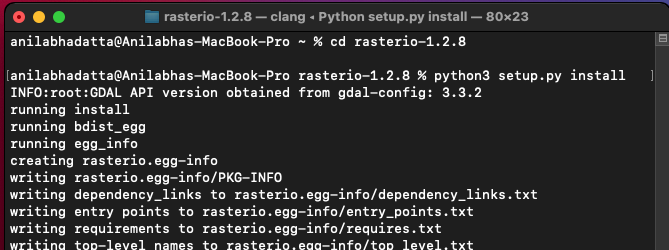

- MAC INSTALL GDAL FOR PYTHON 3 DOWNLOAD
- MAC INSTALL GDAL FOR PYTHON 3 FREE
- MAC INSTALL GDAL FOR PYTHON 3 WINDOWS
Rasterio’s command line interface, named “rio”, is documented at cli.rst. open ( 'example-total.tif', 'w', ** profile ) as dst : dst. uint8, count = 1, compress = 'lzw' ) with rasterio. For # the new file's profile, we start with the meta attributes of # the source file, but then change the band count to 1, set the # dtype to uint8, and specify LZW compression. shape ) for band in r, g, b : total += band total /= 3 # Write the product as a raster band to a new 8-bit file. Adding other # arrays to it in-place converts those arrays "up" and # preserves the type of the total array. Expecting that the sum will # temporarily exceed the 8-bit integer range, initialize it as # a 64-bit float (the numpy default) array. open ( 'tests/data/' ) as src : r, g, b = src. import numpy as np import rasterio # Read raster bands directly to Numpy arrays. This new band is then written to a new single band TIFF. Three bandsĪre read from an image and averaged to produce something like a panchromaticīand. The installation steps for your operating system.Here’s an example of some basic features that Rasterio provides. If, however, you get an error that says command not found, go back and review If all went well, you should get output similar to this: Usage: ogrinfo
MAC INSTALL GDAL FOR PYTHON 3 WINDOWS
Windows users: remember, you'll use the OSGeo4W Shell here. To confirm GDAL installation, open a terminal and type the following command: Newly-installed program, QGIS Desktop, on your system: If QGIS has installed successfully, you should be able to find a Instructions on this are available at All Usersīefore going on, let's verify that the setup process completed successfully. You can also build GDAL yourself, by compiling from source. Once you've added the EPEL repository, run the following command: sudo yum install gdal Follow theħ, assuming epel-release-7-10 is the relevant EPEL release, you would do: su -c 'rpm -Uvh ' In order to install GDAL, you'll need to use the EPEL repository. Option, run the following instead: sudo add-apt-repository ppa:ubuntugis/ubuntugis-unstable To install that version, do: sudo apt-get install gdal-binĪlternatively, if you are running an LTS (12.04, 14.04, or 16.04) youĬan use the ubuntugis-unstable PPA to install GDAL 2+. To check what version of gdal is currently available to you, run the following
MAC INSTALL GDAL FOR PYTHON 3 FREE
Feel free to simple use that package, orĪs of October 2017, Ubuntu's default ( Universe) repositories have GDAL 1.11. Linux Usersįor most users, your Linux distribution's default repository is likely to haveĪ relatively recent version of GDAL. Hit enter after that line, and type the following:Īfter you hit enter again, setup is complete. To finish setup, open your terminal and type theĮcho 'export PATH=/Library/Frameworks/amework/Programs:$PATH' > ~/.bash_profile

Right-click the downloaded file & select Open to begin the installation.Īfter the installation is complete, there's one more step required to enable
MAC INSTALL GDAL FOR PYTHON 3 DOWNLOAD
Here, the 2.x version available for download is GDAL 2.1 Under GDAL Complete, select the download for the GDAL version beginning Information, see the 'Install Note' at the top of thisįollow a similar process to install GDAL from Warning will pop up, but you can continue the installation safely (for more To install, right-click the installer file and select Open. Here, the "Current" version available for download is QGIS 2.18.13-1 To install QGIS, download the QGIS version listed under Current from Installable packages for both QGIS & GDAL. This shell is automatically installed after Once installation is complete, you'll use the OSGeo4W Shell to access command It's possible that someĭependencies will not be installed on the first run.

The OSGEO4W installer & repeat steps 2-5 above. TIP: if you run into issues after the initial run of the installer, re-run If you're running Windows, use the OSGEO4W Installer to download & installĪ variety of free & open source geospatial tools, including GDAL & QGIS.įollow the Quick Start for OSGeo4W Users steps: Download & run the appropriate network installer for your systemĭuring the setup process, make sure to select both the "GDAL" package and


 0 kommentar(er)
0 kommentar(er)
